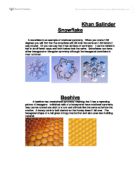Transformation Patterns. Our aim was to take different 3 digit number patterns and make a pattern that was instructed in the worksheet, and then find a correlation between the pattern of numbers and the line of symmetry and the order of rotation.
TRANSFORMATION INVESTIGATION BY Naman Shah & Aman More Aim: Our aim was to take different 3 digit number patterns and make a pattern that was instructed in the worksheet, and then find a correlation between the pattern of numbers and the line of symmetry and the order of rotation. For example if the number chosen was X,Y,Z then we were first supposed to take a starting point, and facing up the page go x square forward and turn 90 degrees clockwise. Then we were to go y squares forward and turn 90 degrees clockwise and then go z square forward and turn 90 degrees. We were to repeat these instructions until we got the starting point. Methodology: We used the software MSWLOGO to create the shapes using the number patterns and formulae to repeat the pattern. Our formula basically gave the instructions: repeat (move x units forward, then turn 90 degrees, now move y units forward, then again turn 90 degrees, finally move z units forward and turn 90 degrees) 4 times. This caused the pattern to be repeated until the time it got back to the starting point (the small square). Using observation, we found the number of lines of symmetry (if any) for each shape, along with the order of rotation. We used this process on 28 patterns using different combinations of numbers. Note: There were many instances where there was line of symmetry. Patterns: Data table: Pattern Numbers
Symmetry in Nature
Khan Salinder Snowflake . A snowflake is an example of rotational symmetry. When you rotate it 60 degrees you will find that the snowflake will still look the same as it did before it was rotated. Or you can say that it has six lines of symmetry. It can be folded in half in six different ways and both halves look the same. Snowflakes can have either hexagonal or triangular symmetry although the hexagonal snowflake is most common. Beehive A beehive has translational symmetry meaning that it has a repeating pattern of hexagons. Individual cells of a honeycomb have rotational symmetry they can be rotated one sixth of a turn and still look like the same as before the rotation. A honey comb is built slanted so that honey doesn't fall over. The hexagonal shape of a cell gives strong construction and also uses less building material. Seashell A seashell has reflectional or bilateral symmetry. A seashell only has one line of symmetry. It can be split in half so that one side is like a mirror reflection of the other side. The lines on a seashell are arranged in such a way that you see perfect symmetry. Animal Most animals are symmetrical in at least one way. For animals, symmetry is related to fitness. Symmetrical horses can run faster than non-symmetrical horses. There are two types of animals; radiata and bilateria. Radiata has radial symmetry. Bilateria




